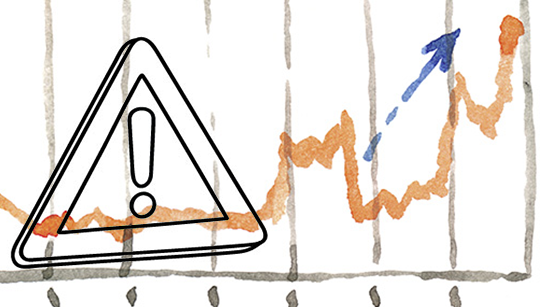Author: 3K Investment Partners

The corporate earnings season is a few weeks underway and looks promising already. Meanwhile, US earnings growth estimates have been upped in recent weeks chiefly as a result of the US tax reform. Nevertheless, we see more upside in margins based on operational improvements in the Eurozone. In addition to the Eurozone, we like emerging markets which we upgraded to overweight.
We hold on to our preference for the cyclically sensitive segments of the equity market and upgraded our positions in emerging market equities and financials.
Corporate earnings are key driver of equity bull market
The bull market in equities seems unstoppable. Depending on one’s perspective, one may feel comforted by the solid underlying fundamentals, or one may start to feel uncomfortable because of the broad-based consensus thinking and increasing optimism among investors. Our views take both sides of the equation into account.
An important driver of the equity bull market is undoubtedly the trend in corporate earnings. In the US, the Q4’2017 earnings season is a few weeks underway and some 15% of S&P500 companies have now reported. The balance is positive; 78% of companies beat expectations. Every sector is doing better than expected, both on sales (+1.2% positive surprise) and on earnings (+3.1% positive surprise). The expectations for the current year are also strong. US earnings momentum (the ratio of earnings upgrades to downgrades) jumped to the highest level in years. Of course, a large part of this is attributable to tax reform and the cut in the headline corporate tax rate from 35% to 21%. Other drivers are the weakness of the US dollar, the strength in oil prices and, last but not least, the global economic recovery. The consensus estimate for 2018 US earnings growth has increased to 16.3%, a rise of nearly 4%-points compared to end-December.
Eurozone earnings growth is of higher quality
The US earnings growth trend shown in the chart above may look impressive this far in the business cycle and compared to other developed markets (Eurozone 2018 earnings growth is estimated at 9.4%), but we should take into account the importance of non-operational items like taxes and currencies. This means that in our view, the quality of US earnings growth is inferior to the quality of Eurozone earnings growth, an element that should be reflected in the relative valuation of the US versus the Eurozone. We see more upside in margins based on operational improvements in the euro region. We believe this divergence in the quality of earnings will lead to a reduction of the current US valuation premium (30%, based on 12-month forward earnings) relative to the Eurozone.
Next to earnings, the equity market – in particular the most cyclically sensitive segments – is supported by the continued strong macro data. Business and consumer confidence indicators are at multi-year highs in developed markets and overall, economic data are coming in above expectations. In addition, given the absence of inflation pressures, central banks have the luxury to maintain their gradual approach towards policy accommodation. Last week, both the Bank of Japan and the ECB confirmed their policy stance.
Investor and corporate optimism is high
Then there is the behavioural side of the equation. Investor optimism is widespread and rising. Equity market volatility has risen somewhat but is still low. For the S&P500 this is one of the longest periods in history without a correction of 5% or more.
The optimism among investors was once again confirmed in the latest investor surveys, which showed lower cash balances in portfolios, a multi-year high positioning in equities relative to the fixed income allocation and a net hedge fund equity market exposure that has risen to the highest level in more than a decade. Corporate behaviour is also bullish, as is evidenced in the rise in M&A-deals. Moreover, the bull/bear ratio remains at very high levels and we see increasing signs of a market that is technically overbought.
This still does not mean that a correction is imminent. Markets can stay overbought for a long time as more and more investors are getting dragged in by the fear of missing out, but the risk of a correction is increasing. For us it is nevertheless a reason not to get carried away and to hold on to our overweight position in equities, but only a modest one. Bear in mind that the only thing that stops a bull market for sure is a recession. Given the current strength in data it looks very unlikely we will have one over the next 12 months.
We upgraded emerging market equities...
We maintain our preference for the cyclically sensitive segments of the equity market. We upgraded emerging market (EM) equities to a small overweight, after having neutralised this position in early December last year. Rising Fed rate expectations and the correction in IT stocks were the main reasons for the downgrade back then. Nevertheless, the EM macro outlook remains solid, driven by accelerating credit growth outside of China. In addition, earnings momentum is rising, while EM equities offer a high 26% valuation discount relative to developed market equities. Furthermore, improvements in short-term behavioural indicators, with strong price momentum and investment flows, support an overweight position. Things to keep a close eye on are the trend in Fed fund futures, which is still clearly upward but until now has had no negative impact, and the strong consensus overweight position in investment portfolios.
...as well as the financial sector
The second change we made is upgrading financials from a small to a medium overweight. First, the performance of the financial sector is positively correlated with bond yields, which have increased in recent weeks and we expect them to rise further in the coming months and quarters. Second, the ongoing economic recovery should have a positive impact on loan growth and the level of non-performing loans. Third, the trend of the past years towards more regulation is reversing. These elements are supportive for the sector earnings. Indeed, global financials have seen a rise in both earnings as well as dividend momentum to well above neutral levels. Finally, valuations are attractive. The discount on price/earnings stands at 25%. Here too, as is the case with EM equities, a factor to watch is the already-high investor positioning.
We hold on to our cyclical sector preference
We hold on to our global sector allocation which is based on three developments: Global macro data, the trend in bond yields and the trend in commodity prices. These elements point towards an overweight in cyclical sectors. Yet, just as for equities in general, investors should tread with caution as the outperformance of cyclical sectors lasts already since the second half of 2016, which, amongst others, has led to extended investor positioning. Cyclical equities do no longer trade at a discount. The premium on price-to-book is around 17% and around 6% on a price/earnings basis. However, we need to take the earnings outlook into account. According to the consensus estimates, earnings growth will primarily be driven by the cyclical sectors. Especially energy, IT and financials will provide a considerable contribution, while consumer staples, utilities and telecom will see their earnings grow at a more modest low-single digit pace.
.png)


